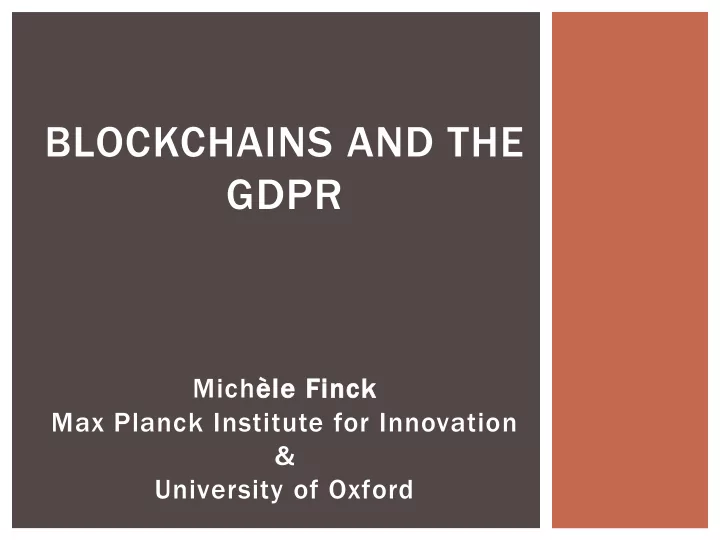

BLOCKCHAINS AND THE GDPR Michèle èle Finck Max Planck Institute for Innovation & University of Oxford
THE GDPR General Data Protection Regulation Dual objective: (i) facilitate the free movement of p. data in the EU: and (ii) give data subjects more control over their personal data Designed for data silos (GAFA platforms) Presumption of what a database is: central collection, storage and processing of data
BLOCKCHAINS AS A DATABASE Decentralized collection, storage and processing of data on public, permissionless blockchains. Decentralized collection: everyone can add data Decentralized processing: transactions are processed by miners / validators Decentralized storage: nodes store data
GDPR: SCOPE OF APPLICATION Where data is anonymous: GDPR does not apply, where it is pseudononymous, GDPR does apply!! Anonymous data: where PD has been processed to ‘irreversibly prevent identification’. PD is ‘any information relating to an identified or identifiable natural person’ (aka the ‘ data subject ’) An identifiable natural person is a person that can be ‘identified, directly or indirectly, in particular by reference to an identifier such as a name, an identification number, location data, an online identifier or on or more factors specific to the physical, psychological, genetic, mental, economic, cultural or social identity of that natural person’
PERSONAL DATA ON A BLOCKCHAIN Transactional data Transactions, messages etc Public keys Personal identifiers on a blockchain
IS BLOCKCHAIN DATA PERSONAL DATA? Data can be stored on a blockchain in three different manners: In plain text (impracticable, expensive, rare) PD remains PD In encrypted form (can be reversed, linked w other identifiers) Encryption as a two-way function, data can be unlocked: mere pseudonymous data = personal data Hashed to the blockchain (cannot be reverse-engineered) Nonetheless PD due to linkability, esp. where input values known) Personal data added to a blockchain remains personal data, GDPR applies
APPLYING THE GDPR TO BLOCKCHAINS Difficult determination of who is subject to obligations inherent to GDPR Prohibition of extra-EU processing of data GDPR obligation of data minimization GDPR right to amendment of personal data GDPR right of erasure (the ‘right to be forgotten’)
CONSEQUENCES Most if not all blockchains are currently incompatible with the GDPR Blockchain as an immature technology Greater techno-legal interoperability in the future?
THANK YOU! michele.finck@ip.mpg.de @finck_m
Recommend
More recommend